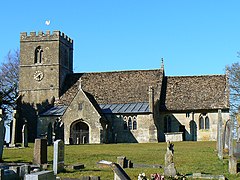Chirton
| Chirton | |
|---|---|
 The church of St John the Baptist, Chirton |
|
| Chirton shown within Wiltshire | |
| Population | 406 (in 2011) |
| OS grid reference | SU073575 |
| Civil parish |
|
| Unitary authority | |
| Ceremonial county | |
| Region | |
| Country | England |
| Sovereign state | United Kingdom |
| Post town | Devizes |
| Postcode district | SN10 |
| Dialling code | 01380 |
| Police | Wiltshire |
| Fire | Dorset and Wiltshire |
| Ambulance | South Western |
| EU Parliament | South West England |
| UK Parliament | |
| Website | Parish Council |
Chirton is a village and civil parish in Wiltshire, England, on the southern edge of the Vale of Pewsey about 5 miles (8 km) southeast of Devizes. The parish includes the hamlet of Conock.
The settlements are just off the A342 Devizes-Andover road. To the south the parish extends onto Salisbury Plain.
Chirton (17 households) and Conock (18) were recorded in the Domesday Book of 1086. At that time Conock was held by Grestain Abbey, Normandy; in 1324 the land was seized by the king, along with other alien priories.
Conock Manor (c. 1700) is Grade II* listed. Pevsner describes it as "a Georgian house of great charm".
The population of the parish peaked around the middle of the 19th century, with 467 recorded at the 1851 census, declining to 261 by 1901.
When the Stert and Westbury Railway was opened through the Vale in 1900, the nearest station was near Patney, 1 mile (1.6 km) north of Chirton village. Known initially as 'Patney Bridge', this was soon changed to 'Patney and Chirton' to avoid confusion with Putney Bridge station in London. The station closed in 1996.
The Church of England parish church of St John the Baptist has Norman features; in the 12th century the church was granted to the newly established Llanthony Secunda priory at Gloucester, and the 12th-century font survives. The present tower was added in the 15th century. A severe restoration was carried out in 1850. The church was designated as Grade I listed in 1962.
...
Wikipedia

